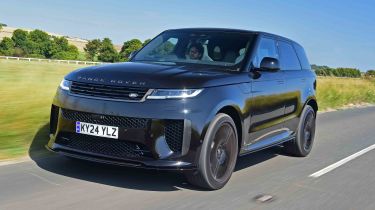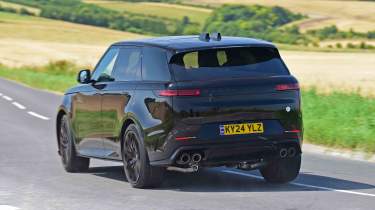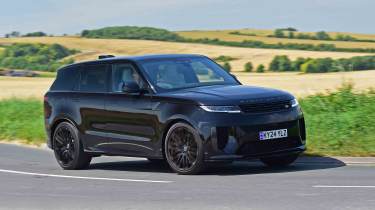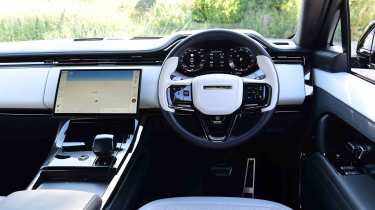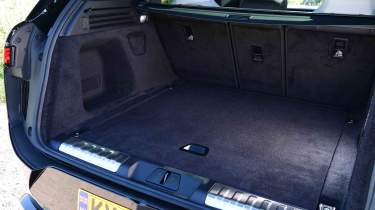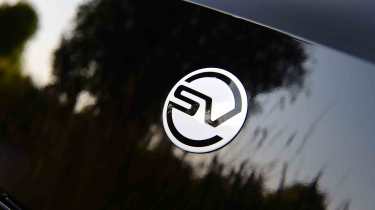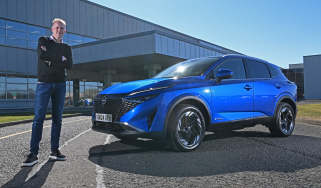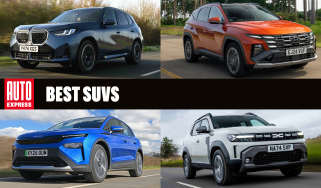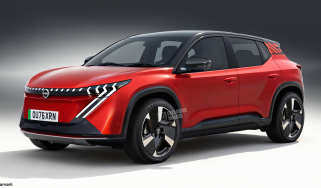Range Rover Sport SV review
The Range Rover Sport SV offers stunning pace, while retaining the standard car's impressive levels of comfort and off-road ability

Is the Range Rover Sport SV a good car?
It’s hard to emphasise just how much of a giant leap forward the Range Rover Sport SV has taken over the previous SVR. The innovative new suspension is transformative to its handling, and despite being a very big and very heavy SUV, is still devastatingly fast and capable. That it does this without compromising on-road comfort or off-road ability is even more impressive.
|
Key specs | |
|
Fuel type |
Petrol |
|
Body style |
Luxury high-performance SUV |
|
Powertrain(s) |
4.4-litre V8, twin-turbocharged, eight-speed automatic, all-wheel drive |
|
Safety |
5-star Euro NCAP (2022) |
|
Warranty |
3yrs/unlimited miles |
How much does the Range Rover SV cost?
Land Rover is offering the Range Rover Sport SV in limited variations of specification and trim. With the Edition 1s sold through, we’re now onto Edition 2, which has a base price of £171,800, and can be specified individually or in one of four ‘SV Themes’. These range in cost from £173,800 to £187,100, and offer different colour, trim and wheel options.
Beyond this, you can specify any one of those four colours on a base spec, choosing various carbon trim options, wheel designs and brake caliper colours. Optional extras are limited, but high-priced £6,900 carbon fibre wheels and £7,000 carbon ceramic brakes do benefit the handling as much as they do design. Beyond this, only a £680 Convenience Package or two sunroof options can be added.
Engines, performance & drive
Gone is the old supercharged 5.0-litre V8, and in its place is a 4.4-litre twin-turbocharged V8 (originally a BMW sourced unit, but with plenty of Range Rover-specific tuning) with mild-hybrid tech. The result is 626bhp and 750Nm of torque – 60bhp and 50Nm up on the old SVR, yet with emissions reduced by 15 per cent. It’s all sent to the road via an eight-speed gearbox, all-wheel drive system and an active rear differential.
Used - available now

2022 Land Rover
Range Rover Sport
46,978 milesAutomaticPetrol2.0L
Cash £34,787
2022 Land Rover
Range Rover Sport
42,054 milesAutomaticPetrol2.0L
Cash £37,600
2022 Land Rover
Range Rover Sport
35,815 milesAutomaticPetrol3.0L
Cash £43,100
2022 Land Rover
Range Rover Sport
19,523 milesAutomaticPetrol3.0L
Cash £47,300A 0-62mph time of 3.8 seconds (or 3.6 with the carbon wheels) is more than rapid enough to keep pace with the competition, though the cabin is so serene that it makes the relentless surge feel all the more surreal. There’s a little too much traction for the four wheels to slip much in the dry, but there is a rear-biased power delivery, which adds to the excitement.
Less exciting is the noise; the engine makes a pleasing and slightly muted growl, but it can’t match the sense of occasion of its predecessor’s roaring supercharged V8.
However, Land Rover’s progress is more evident in its handling, which has transformed from being sometimes fraught, to borderline brilliant. In no world should a 2.6-ton SUV handle with anything like as much clarity or poise as this new SV.
To turn the SV into a driver’s car, changes over the base Range Rover Sport have been extensive, and the obvious place to start was with the suspension. Here, the air springs are kept in check by unique hydraulically-interlinked adaptive dampers and a pitch control system – an industry first, according to Land Rover.
The semi-active arrangement can give a very wide bandwidth between comfort and stability, but also precise control over each corner. It’s so effective at controlling the body, it means Range Rover has been able to do away with anti-roll bars altogether.
The height-adjustable air springs sit 10mm lower than in the standard car in its default setting, which dictates all-new geometry. Land Rover’s also fitted the most direct steering rack fitted to one of its models yet, which works with a recalibrated rear-wheel steering system. A set of 23-inch forged wheels save unsprung mass compared to standard rims, and the result is that the SV can pull 1.1G through the turns. On all-season tyres.
|
Model |
Power |
0-62mph |
Top speed |
|
Range Rover Sport SV |
626bhp |
3.8 seconds (3.6 with the carbon wheels) |
180mph |
However, spend another £6,900 and Land Rover will fit a set of 23-inch carbon fibre wheels. At this size, they’re another world first, and help to trim a whopping 8.9kg more on each corner. The carbon wheels come wrapped in a set of Michelin Pilot Sport 5 summer tyres developed specifically for this car, which sees that peak G figure climb even higher.
Further weight is saved with optional carbon ceramic brake discs (£7,000), which trim another 34kg compared to the cast iron discs. The items up front measure 440mm – that’s over 17 inches, or larger than the wheels of many family cars – and are gripped by unique Brembo calipers. Its eight pistons form a cross shape, which allows sufficient braking force while bringing some of the weight closer to the centre of the wheel.
These weight saving measures, plus a carbon fibre bonnet and a range of other carbon trim pieces on the SV-specific body kit, help to trim 76kg from the overall weight. It doesn’t change the fact that there’s still significant mass to haul around, mind.
The effect on-track is stunning. Push into a corner in a way that would see the standard car wallow on its air springs and the stability control kill forward momentum, here the turn in is positive and grip is enormous.
Prod the SV button on the steering wheel and things become even sharper. The suspension drops a further 15mm (giving the side effect of more negative camber), stiffens the dampers, and changes the response of the throttle and gearbox. The interlinked suspension is almost spooky in its ability to contain body roll; were it not for the commanding view of the road ahead, you’d be convinced you were driving something as low-slung as a Porsche Panamera.
It achieves all of this while maintaining just enough movement to register how your throttle inputs can adjust the car’s balance. Lift off the right pedal through the long final corner leading onto the long start-finish straight, and the nose dutifully tucks back towards the apex. As the corner gradually opens out and the speed increases, you do become aware of the car’s mass, but for the most part it’s incredibly well contained.
The steering helps here, too. While some four-wheel steering systems don't quite feel like the axles quite sync up, but here the rack feels so natural, precise and confidence inspiring. There’s just enough speed to make it feel keen to turn in without feeling hyperactive.
We’ve also driven the Range Rover Sport SV on British roads without both the carbon fibre wheels and ceramic brakes and things are almost as impressive. There’s still that innate sense of complete road-holding and poise, but on smaller roads there’s no denying that this is still a very big and very heavy machine, posing the question of whether this level of performance is required, let alone justifiable. As an engineering exercise, however, Land Rover has nailed it.
MPG, CO2 & running costs
Land Rover quotes an on-paper efficiency rating of 22.7mpg on the combined cycle, and it’s a figure that in mixed conditions is attainable with a careful right foot. In fact, over the course of a few days in a combination of some urban and motorway driving, we averaged closer to 25mpg, with a slower motorway journey getting this figure closer to 29mpg after resetting the trip.
This all seems very impressive until you unleash the full potential of the twin-turbocharged V8, after which it’ll easily dip into the low-teens. Take it anywhere near a track and you’ll forge into single-digits. A CO2 figure of 282g/km puts it into the top bracket for many CO2 sensitive brackets, such as road tax, BiK or even urban parking permits.
|
Model |
MPG |
CO2 |
Insurance group |
|
Range Rover Sport SV |
22.7mpg |
282g/km |
50 |
Running costs are also likely to be equivalent to the sort you’d expect of a super-high cost SUV, and potentially a little more. The big 23-inch tyres are an expensive consumable, and will likely wear faster than lesser Range Rover Sport models due to the more aggressive suspension geometry that makes it so much better to drive on the road. Carbon Ceramic brakes ‘should’ last the life of the car, but they still are susceptible to wear – don’t expect the pads to be cheap either.
Design, interior & technology
The interior of a modern Range Rover has long been one of its highlights, and that’s the case here with the SV, too. Climb up into the driver’s seat and you’ll notice there’s a particular level of opulence that takes it over and above many of its German rivals; even if the overall build quality isn’t quite as solid.
Materials on the SV are at Bentley levels of luxury; the leather is soft and supple, metal work cool to the touch and finished in a darkened chrome. There’s also lots of SV-specific materials to enjoy, too, including a bespoke chopped carbon finish – a matte-finish weave is also available – clear acrylic on the steering wheel-mounted paddles and SV button, and a clever 3D woven material on the seat backrests.
In fact, those seats come with a Range Rover-specific oddity that is an almost complete lack of lower bolstering. This is due to the car’s high ride height, allowing for ingress and egress, but they do compromise on lower-thigh support. We also didn’t find them to be quite as comfortable in general as the best seats in the business, but their integrated massage function is one of the more effective in the luxury SUV class.
One seemingly minor, but actually rather important, touchpoint that doesn’t present so well is the gear selector. As with all SV Range Rover variants, it’s made from a faux porcelain finish that comes across more as cheap hard plastic than something you’d find in the Selfridges homewares department. Add to this the light and cheap-feeling mechanism of the shifter itself and it results in a fairly cruddy touchpoint that you come into contact with every time you set off and come to a stop.
Sat-nav, stereo and infotainment
JLR’s Pivi Pro infotainment system has consistently impressed across all models it’s been fitted to, and for the most part the same sentiment applies to the latest Range Rover Sport SV. The curved 13.3-inch touchscreen is quick to respond, and the user interface is well judged and easy to navigate.
Wireless Apple CarPlay and Android Auto work seamlessly within the system, but there is a caveat to the system in that Land Rover has also ditched the physical controls for the climate and drive mode functions. Now, they’re relegated to touchscreen, which means the need to swap between the native and phone-mirroring software.
These elements can sometimes be well integrated, if the digital interfaces are big enough, but in the case of the Pivi Pro system, it’s not. It just isn’t as intuitive as the dials and buttons that have been replaced.
The top-spec Meridian sound system is fitted as standard on the SV, and offers some considerable punch. It also works collectively with a feature Range Rover calls its ‘Body and Soul System’. This sees four transducers (similar to the haptic generators as you’ll find in your iPhone) fitted within each seatback that work with AI software to send pulses through the seat, replicating the lower frequency notes and rhythms of your favourite music. They’re a little odd at first, but once you’ve got used to it, listening to music without them seems just a little flat and boring. It can get a little tiring on long journeys, though.
Boot space, comfort & practicality
All Range Rover Sport models of this generation are a five-seat only proposition, and the same is true of the SV. As a result, there’s no compromise in the second row in terms of space, liberating plenty of legroom, but there’s not much in the way of adjustability back there.
The wide body all Range Rovers offer does mean three can sit abreast quite comfortably, but the SV’s more contoured second row does make sitting in the centre rear seat a little less comfortable than base cars. Space up front is good, of course, however the tall centre console does make it feel a little less spacious than a full-sized Range Rover.
|
Dimensions | |
|
Length |
4,970mm |
|
Width |
2,209mm |
|
Height |
1,814mm |
|
Number of seats |
Five |
|
Boot space |
522-1,686 litres |
Range Rover has done impressive things with its new 6D suspension system, meaning that despite its extraordinary ability to keep the body level under hard cornering, the system is also very adept at creating a comfortable ride. Getting technical for a moment, the system negates the need for traditional anti-roll bars, meaning the wheels are more truly independent than they are on non SV models. This has multiple benefits, including increasing wheel travel over the base car, which already has plenty.
This is somewhat undone by the 23-inch wheels, which can sometimes crash into big potholes, but there’s still plenty of compliance and isolation in the cabin. Models fitted with the carbon fibre wheels and carbon brakes ride even better, thanks in large part to the big decrease in unsprung weight.
Safety & reliability
All Range Rover Sport models achieve a maximum five-star safety rating and the SV is no different. It scored highly across the board thanks to comprehensive active and passive safety systems.
What’s less rock-solid is reliability where Range Rovers, and Land Rovers in general, don’t have a great reputation. There is some solace to be had in the engine’s sourcing from BMW, but all Range Rovers are complicated creatures, and this shows in their overall reliability ratings.
In our Best Manufacturer survey, Land Rover came in at 10th. But it scored low on reliability, running costs and overall value, owing its high placement to brand loyalty.
|
Key standard safety features |
Euro NCAP safety ratings |
|
|
Range Rover Sport SV alternatives
High-end high-performance SUVs continue to do big business for brands at the top-end, so it’s not surprising to see more ultra-high performance SUVs on the markets than superminis in 2024. Key rivals from the premium brands include the Audi RS Q8, BMW X6 M Competition, and Mercedes-AMG GLE 63 S – each come with a similar twin-turbocharged V8 engine with no, or only mild-hybrid assistance.
Looking into the luxury sector, the Bentley Bentayga V8 S is a potential rival, but is nearly 100bhp down on power and takes a more comfort-biased route in terms of its handling setup. Supercar brands are also in on the action, with the Aston Martin DBX707 being arguably the closest to the SV in terms of speed and opulence.
There are now also a few hybrid options vying for top spot, with the Porsche Cayenne Turbo E-Hybrid with the GT Package offering the same brilliant chassis upgrades as the previous Turbo GT. The Lamborghini Urus SE shares a similar powertrain, but comes with its own set of fairly substantial updates inside the cabin and out.
Take a step further out and you’ll have the BMW XM, which has done little in terms of sales, but offers the same V8 engine as the SV with a plug-in hybrid model attached. Two other two big hitters come in the form of the Mercedes-AMG GLS 63 AMG, which is the biggest ultra-high performance model from the brand and, of course, the iconic Mercedes-AMG G63, which continues to outperform nearly all its rivals in the sales charts, despite a price point above even that of the SV at over £180,000.
Frequently Asked Questions
Like all Land Rover products, the Range Rover Sport SV has a three-year warranty with unlimited mileage. You can also extend the warranty by a further three years through Land Rover.
